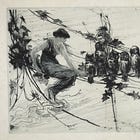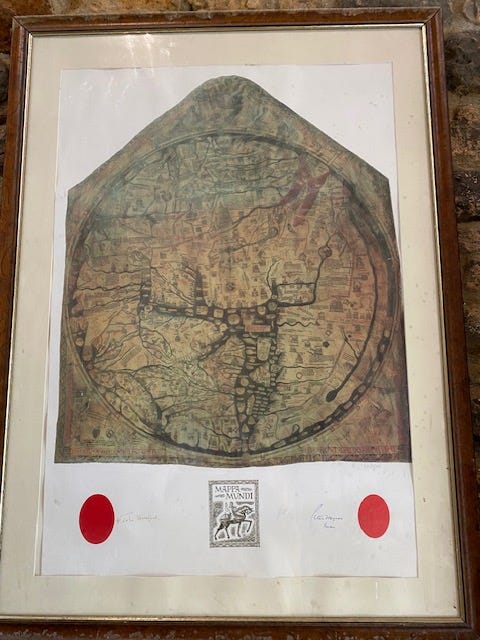The Village #3: Wisdom Sits in Places
Some partial thoughts about stories, maps, place, and participation, ft. Barry Lopez and Rachel Carson. Plus some reading
Welcome, especially new subscribers. My last post contained 40 pieces of thought, knowing, and goodness, to mark my 40th birthday. If you missed it you can read it here:
Here’s the first and second post in this series, which explores the village it takes to raise our children, ourselves, and our future — especially in this rootless and trembling age.

“Place is the first of all beings, since everything that exists is in a place and cannot exist without a place” - Archytas, cited by Simplicius, and referenced in Keith H.Basso’s Wisdom Sits in Places: Landscape and Language Among the Western Apache
I heard a story when I was in a village in Pokot, in western Kenya, that went something like this: a well-known aid organisation had funding to provide boreholes to access clean water. They conducted a ‘focus group’ with the community, who told them the boreholes should not be drilled in a certain place, for that place held the spirits of their ancestors. The charity’s engineers said it was the only viable place for the boreholes, so drilled there anyway. The boreholes were not used — residents continued to walk to the river and risk water-borne illness rather than disturb their ancestors anymore. “A cheaper and better solution” one of the community leaders told me, “would have been to give us ceramic filters to use at the river. But that did not suit their objectives, their donors.”
My experience of working with communities across Africa, and more recently across rural Devon, was that the place was rarely intentionally taken into account in projects. We’d think about needs, resources, practical things, but I don’t think we meaningfully took into account how local stories might play a role. That changed a bit in some of my later charity work — we spent time village-by-village, family-by-family, listening to stories, and thinking how they might shape the present and future of a place. The approach was not about neat projects, but rather the messy beauty of people, their relationships, their places, and their vision. It was flawed, but the approach felt human. It acknowledged and celebrated the complexity and possibility of community.
A few months ago, I looked around a church which had on one wall a framed copy of a ‘Mappa Mundi’ — a medieval map made in about 1300. At that time, people were encouraged to hear, read and see the history that the map presented, more than use it as a navigational tool. It depicts 420 towns, 15 Biblical events, 33 animals and plants, 32 people, and five scenes from classical mythology. It also depicts monsters and inhuman races. These maps held our ancestors’ beliefs about what mattered in the world, and about our relationship to others who inhabited it. The map does not correspond to geographical knowledge at the time: stories and symbolism seemed to shape the world more than geography did, in some ways echoing the community in Kenya and in other places I’ve been.
And these things still do shape our world. Places, nature, people, myths and monsters all bound up, giving us our own as well as shared maps. Perhaps one of the challenges of living now is aligning these maps. How do we use the maps we carry when they might be very different to our neighbours’? And how does this shape the communities we create?
Modern maps don’t carry the meaning of home and of belonging; these meanings are bound up in events, people, landscape. Where we live in rural Devon — an area of Devon we knew very little before we moved here — people sometimes give directions using names and stories and people. It tells me about local beliefs about what matters, about the relationship between people and place, like a local and oral ‘Mappa Mundi’. I am trying to put myself into this map. It is hard, vulnerable, joyful, brain-rewiring, place-making work.
To help with the challenge of learning to be in a place, I turn to writers who have a strong sense of place, like Gretel Ehrlich, Barry Lopez, Annie Dillard, Thomas Hardy. In an age of uprootedness, I think knowing a place can be hard, and so it seems important to pay attention to those who know how to do so. In better knowing our own places and their people, we might better be in them, better respond to them, better contribute to their present and future, and so to our own.
The late essayist Barry Lopez, despite travelling the world widely, said his favourite landscape was around his home in Oregon. He reflected how this landscape “must appear innocuous, ordinary.” He goes on: “still, I’m happy in this undemonstrative, rural place. In my conversations with it I know, once more, who I am…If I want the comfort of intimacy with it, of integration and acceptance, my only choice is participation – to learn from it by participating…of not opting for the expediency of detachment.”
Some days, detachment is all I want. But becoming a mother has, I think, opened me to new ways of seeing and caring, and keeping that within the four walls of our little family feels like hoarding, especially when the world so badly needs care. Some days, I desperately want participation, but all I feel is detachment. Those four walls never existed for our ancestors. We are group-loving creatures who have shut ourselves away.
All this to say, care and participation and place and belonging feel linked. Finding or building a village must, I think, be embedded and embodied in a place: somewhere we can hear and contribute stories, somewhere we are part of an ecology of care that goes deeper and probably feels harder than often transient, self-selected, fragmented online communities. That’s not to say online connection isn’t important: some days, I feel the most likeminded interactions I have are with people I’ve connected with online. And the physical world can be isolating at times, for some more than others.
But there is something about a physical place that feels important for village-building. Rachel Carson wrote that “our origins are of the earth. And so there is in us a deeply seated response to the natural universe, which is part of our humanity.” I have been thinking a lot about how we are of the earth. I think in an age of uprootedness, where so much happens digitally and fleetingly, the earth is calling us back again. And we know the earth by its places.
Our attachment to places — which aren’t necessarily the same places we build our villages — can be mysterious, sometimes older than our existence and beyond our words. As I think about village-building, I am thinking about the role of place, and about the level of autonomy I need to give up in order to sink into the stories, rhythms, and communality of a place — to hold and to be held, and to help my daughter feel the same. As someone who is generally fairly private and independent, all of this feels as hard as it feels necessary.
Do you feel part of a place? — by circumstance, choice, participation, something else? Do you feel part of the community of that place? How are these things linked? I’d love to hear your thoughts and experiences.
Some recent reading on places, their stories, and who tells them:
Hillbillies Need No Elegy, by Meredith McCarroll in The Bitter Southerner. After JD Vance, author of Hillbilly Elegy, was named as Trump’s running mate in the US election, this piece felt timely. It’s extracted from the many-voiced 2019 book, Appalachian Reckoning: A Region Responds to Hillbilly Elegy.
“Appalachia has been shaped by outsiders’ images and strangers’ descriptions. As a result, complexity gets simplified, the edges get rounded out... Appalachia has been written about and photographed in such a compelling (if fabricated) way that the descriptions of passersby took on more weight than the lived experiences of the people being described. What remains is a concept of a place that is both wildly romantic in its natural beauty and backward enough to justify the destruction of that very nature.”
Island Home, a memoir by Tim Winton. How Australia’s landscape makes Australians who they are, written against a backdrop of the “postmodern and nearly post-physical age we live and work in”.
Wisdom Sits in Places: Landscape and Language Among the Western Apache, by Keith H.Basso. An (outsider’s) exploration of what places, their names, and their spirits means to the Apache people — how these things connect individuals to community to place to history.
Thank you for reading RedLands. If you value anything here, then please consider upgrading for £4 a month / £35 a year — becoming a paid subscriber supports me and my work and gives you access to occasional exclusive posts, e.g. about the book I’m working on. (Super supporters also get a handwritten card and a coaching session on a topic of their choice if they want one). I’m very grateful for everyone who reads my words.





